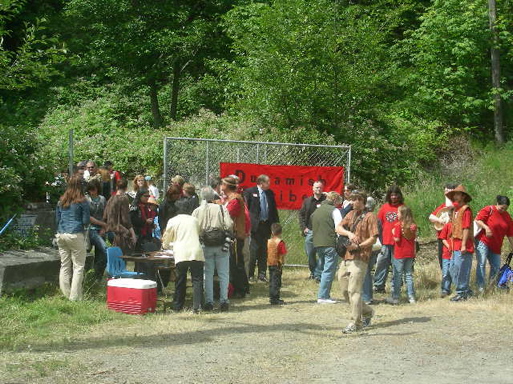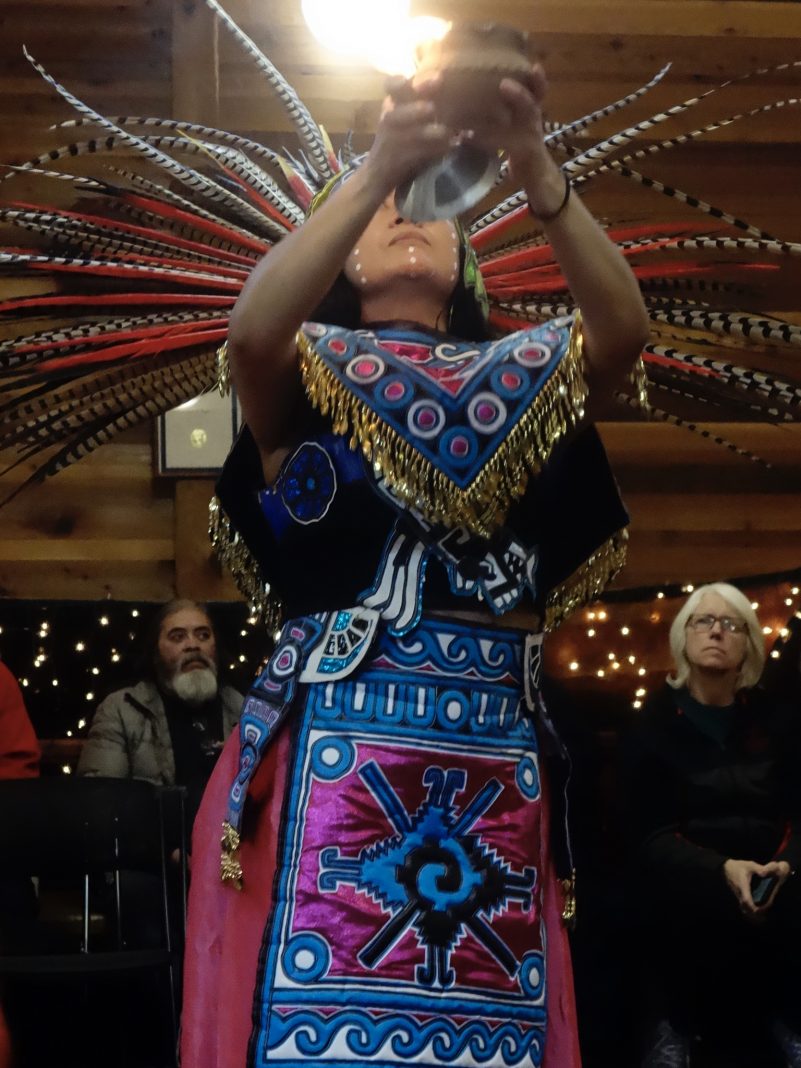By Tracy Record
West Seattle Blog editor
Though the Duwamish Tribe Longhouse in West Seattle is celebrating its 10th anniversary this month, its origins go back decades.
Joleen Haas, the Longhouse’s director, observes that it “really started 30 or 40 years ago … the purpose was to have a home for the Duwamish but also a place to share our history with, and educate, everyone. We surveyed the membership and asked, what more do you want besides (federal) recognition? They said, they wanted a longhouse.” It would be the first since in more than a century, since settlers burned almost 100 Duwamish longhouses in the 1800s and early 1900s.
The search for a site was not easy. The search ranged far and wide, “until the Friends of the Duwamish found this property,” recalled Haas, daughter of Duwamish chair Cecile Hansen, during a recent interview with us at the Longhouse. Finally a site was found in West Seattle, a former dumpsite as Haas recounts. “As soon as we got the land we started planning.” More of the history is recounted on the tribe’s website:
The Duwamish Longhouse and Cultural Center is located on the west side of West Marginal Way in West Seattle overlooking the Duwamish River valley near a village site where the young Chief Seattle grew up. Our Center is across the street from a major archeological site, Duwamish Site No. 1 (45-KI-23), a designated site in the National Register of Historic Places. Archeologists have uncovered a major village dated back to 600 A.D. It was occupied during the fall, winter and early spring and was known for a gathering place for shellfish from the tide flats of the original Duwamish River. Shell middens along the riverbanks are still visible: This is the only remaining stretch of the original Duwamish River.
Tribal Elders in 1927 called the village Ha-AH-poos, had its own shaman (healer), several longhouses, and hundreds of inhabitants that lived there in the 1800’s. Directly north of Ha AH-poos is another major former village, Tul a’lt, or Herrings House, now Herrings House Park. This large village consisted of four medium-sized longhouses (100 ft x 50 ft) and a larger potlatch house more than 300 feet long.
The 6,000-square-foot Duwamish Longhouse’s groundbreaking ceremony was held in June 2007:

(WSB photo, June 2007)
A year and a half later, the Longhouse was dedicated, on January 3, 2009.
So what’s the first decade been like? “We’ve managed to make it through based on a very (simple) business plan,” Haas said. “No debt. Not relying on grants. Using rentals, gift shop, tours, as a way to operate.” And now it’s time for them to take the next step – for which they have planned “more capacity building … We’re trying to up our game here, trying to plan new and innovative exhibits,” among other initiatives.
A big part of that, Longhouse consultant Dr. Jeffery Perkins Jr. says they are working on a “plan to connect the Duwamish Longhouse with the lucrative tourism industry.” With tourists spending tens of millions of dollars in Seattle every year, he notes, the tribe should be able to “get part of that.”
For visitors from near and far, they are also seeking pedestrian-safety improvements on West Marginal Way SW, which is a treacherous street to cross.
As noted at the most-recent West Seattle Transportation Coalition meeting (WSB coverage here), they’re seeking a city Neighborhood Street Fund grant in the community-prioritization process, which starts tomorrow (Monday, January 28th) online and includes meetings February 2nd (10:30 am, Youngstown Cultural Arts Center) and 4th (6:30 pm, South Park Hall).
Haas adds that the shortage of public transportation in the Longhouse area is a concern too. While the city included it as part of the pilot area for the Ride2 on-demand shuttle, the Longhouse doesn’t open until 10 am – after Ride2’s morning service period ends. The tribe hopes to strike partnerships to get more visitors to the Longhouse in summertime, rather than being bypassed. For example, they point out, Argosy Cruises sails by on the Duwamish River – “let your customers know we’re here” is the Duwamish Tribe’s message.
“This place has value, right here, and the city needs to know that,” Dr. Perkins emphasized.
Meantime, the anniversary celebration will last all year long, Haas emphasizes. Saturday’s open house included newly unveiled art and a screening of the documentary “Promised Land“:
Indigenous dancers performed:
And a ceremony thanked supporters, including those involved with the Real Rent movement:
The tribe’s website lists upcoming events, another way they’re working to let people know what’s going on at the longhouse – as their reminder to all goes, The Duwamish “are still here.”
And still fighting for federal recognition. Before the change of presidential administrations, Duwamish chair Cecile Hansen took that fight to then-Interior Secretary Sally Jewell, face to face in West Seattle, in 2015.

(August 2015 WSB photo by Tracy Record)
Despite setback after setback, it’s “definitely not over,” Haas says, and they want people to know that. “No matter what happens … we are a treaty tribe, and we’ve never relinquished that. We should be dealt with as such. We never gave up our sovereignty.”
There are many more chapters ahead in the tribe’s centuries-long story. You can continue learning about Seattle’s First People by visiting their now-decade-old Longhouse and Cultural Center (4705 W. Marginal Way SW; map), Tuesdays through Saturdays, 10 am-5 pm.






| 2 COMMENTS